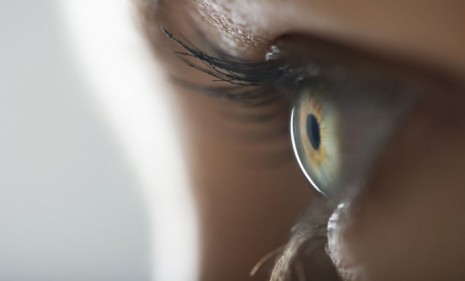The microchip that let a blind man see
German researchers have partially restored sight in three patients using eye implants

In what's being called an "amazing step," German researchers have helped people recognize shapes and even letters despite a degenerative disease that had left them blind for years. (Watch a NewScientist report about the microchip.) Here, a brief guide to their findings:
What helped the patients see again?
A microchip implanted beneath their retinas. Researchers at the University of Tuebingen in Germany put the chips into 11 patients who had been blind from two to 15 years as a result of a degenerative disease called retinitis pigmentosa. After the operation, most were able to recognize bright objects. Three could read clocks and decipher some letters, and one was able to read words and distinguish between seven shades of gray. Such miraculous improvement was, "up until now, thought to be in the realms of science fiction," says Robert MacLaren, a British ophthalmologist who plans to perform the first chip implants in the United Kingdom.
The Week
Escape your echo chamber. Get the facts behind the news, plus analysis from multiple perspectives.

Sign up for The Week's Free Newsletters
From our morning news briefing to a weekly Good News Newsletter, get the best of The Week delivered directly to your inbox.
From our morning news briefing to a weekly Good News Newsletter, get the best of The Week delivered directly to your inbox.
What exactly is this eye implant?
It is a tiny plate that sits entirely within the eye. It is just 3 by 3 millimeters in area and one tenth of a millimeter thick — yet it contains 1,500 light sensors. A thin wire connects to the implant and runs under the skin to a spot behind the ear, where it can be connected to a control box and power supply. The control box can be used to adjust brightness and contrast levels.
How does it work?
The externally powered chip transforms light that hits the eye into electrical impulses that are fed into the optic nerve. "It's really fascinating work, but it doesn't restore vision," says David Head, of the British Retinitis Pigmentosa Society. "It rather gives people signals which help them to interpret." There's a rival chip manufactured by an American company, but it sits on top of the eye and patients must be fitted with a camera attached to a pair of glasses.
A free daily email with the biggest news stories of the day – and the best features from TheWeek.com
Will this lead to a cure for blindness?
No, but it could some day become a routine treatment for the more than 200,000 people worldwide who are blind due to retinitis pigmentosa. But first more trials. The next step is putting the implants into 25 to 50 patients around Europe. "It will be a while before there is a reliable, marketable device," says researcher Eberhart Zrenner. "It's important not to raise false hope." But these findings could lead to more breakthroughs, says David W. Freeman at CBS News. "With further development," he says, "the developers of the implant see a future in which it might work to restore vision to people suffering from age-related macular degeneration — the leading cause of vision loss in older people."
Sources: Live Science, BBC News, Reuters, CBS News
-
 US citizens are carrying passports amid ICE fears
US citizens are carrying passports amid ICE fearsThe Explainer ‘You do what you have to do to avoid problems,’ one person told The Guardian
-
 All roads to Ukraine-Russia peace run through Donetsk
All roads to Ukraine-Russia peace run through DonetskIN THE SPOTLIGHT Volodymyr Zelenskyy is floating a major concession on one of the thorniest issues in the complex negotiations between Ukraine and Russia
-
 Why is Trump killing off clean energy?
Why is Trump killing off clean energy?Today's Big Question President halts offshore wind farm construction